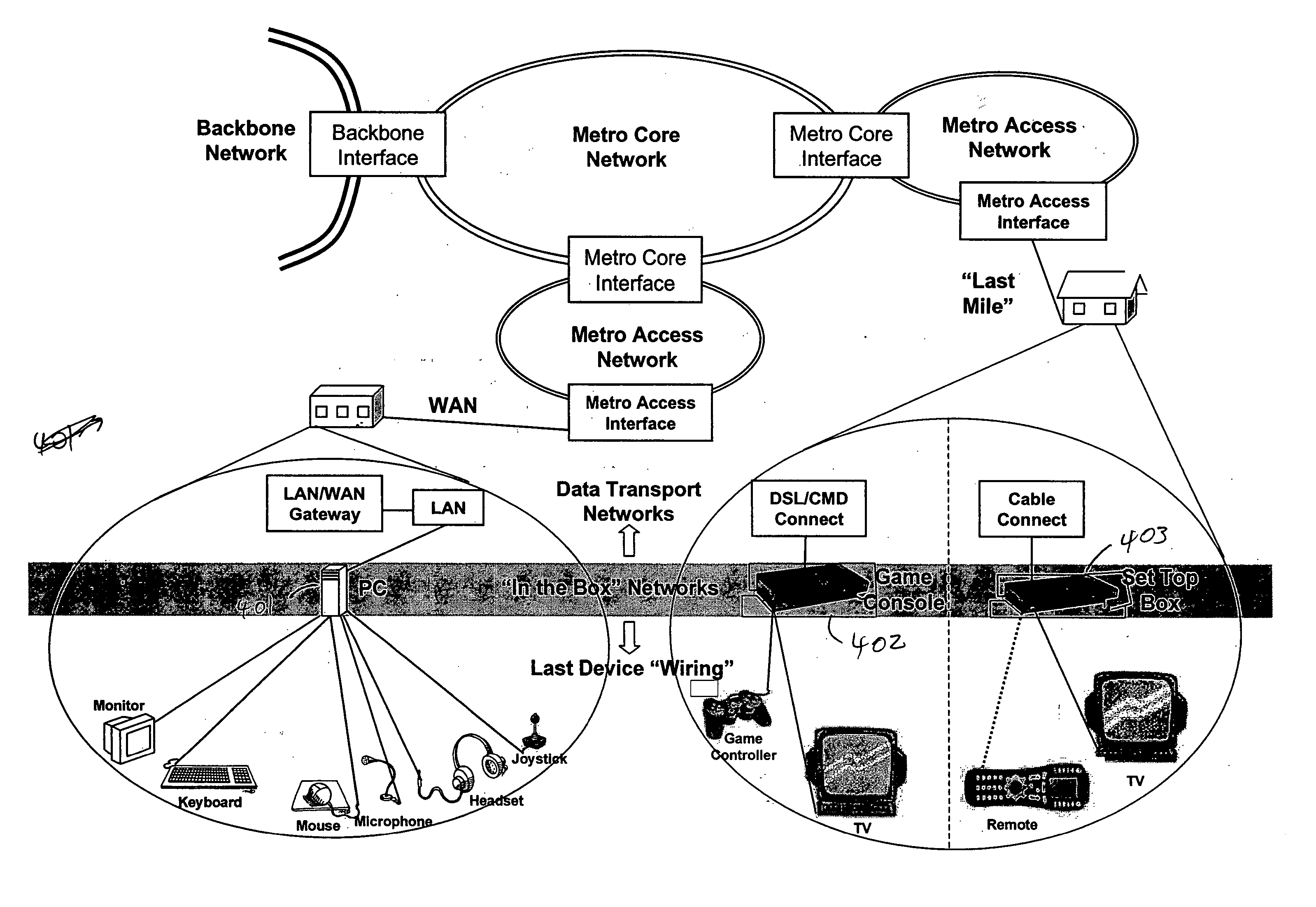[0017] These and other problems are solved by a remote interface network in which multiple remote HID encoder/decoder units share a common physical transport medium for connecting to one or more processing unit encoder/decoders. In one embodiment, the physical transport medium includes an optical shared media transport network. Each remote HID encoder/decoder unit can support one or more remote HIDs. The processing unit encoder/decoder can support one or more Pus. The network can be used, for example, in office, hospital, dense seat (e.g., aircraft, bus, etc.) and content provider networks.
[0018] In one embodiment, a remote interface network provides multiple remote human interface device encoder/decoder units that can share a common physical transport medium for connecting to one or more processing unit encoder/decoders. Each remote encoder/decoder unit can support one or more remote devices some of which can be human interface devices. The processing unit encoder/decoder can support one or more processor units.
[0019] In one embodiment, an HID network provides one or more remote stations having a set of interface devices associated with a user and a station encoder/decoder. A digital transport network is provided to connect to one or more content sources (PUs) through a crossbar switch. The encoders convert native format signals into one or more serial bit streams for transport over the digital transport network. The decoders convert one or more serial bitstreams into native format signals to drive native devices. The crossbar can be configured to broadcast one processing unit channel to multiple stations, to multi-cast one processing unit channel to multiple stations, to form a point to point connection between one processing unit and one station, or a combination of multicast and point to point connections. The control of the crossbar can be external, from control signals extracted from the station's serial bit streams as they enter the cross bar, or from control signals from the processor units.
[0020] In one embodiment, a remote device interface network, includes a first processing unit configured to provide at least a first raw video output signal for a first video display, a second processing unit configured to provide at least a second raw video output signal for a second video display, a first processor-side encoder/decoder configured to convert the first raw video output signal into a first serial digital sampled data stream, a second processor-side encoder/decoder configured to convert the second raw video output signal into a second serial digital sampled data stream, a first HID-side encoder/decoder configured to convert the first serial digital sampled data stream into a representation of the first raw video output signal, a second HID-side encoder/decoder configured to convert the second serial digital sampled data stream into a representation of the second raw video output signal and to convert signals from an output signal from a human interface device into a third serial digital sampled data stream, and a shared-media transport layer configured to provide bi-directional communication between the first and second processor-side encoder/decoders and the first and second HID-side encoder/decoders by transporting the first and second serial digital sampled data streams in a downstream direction and transporting the third serial digital sampled data stream in an upstream direction. In one embodiment, the shared-media transport layer includes a fiberoptic system. In one embodiment, the shared-media transport layer includes single-mode fiber. In one embodiment, the transport layer includes coaxial cable. In one embodiment, the transport layer includes twisted-pair cable. In one embodiment, the first raw video output signal includes a VGA video signal. In one embodiment, the first raw video output signal includes an NTSC video signal. In one embodiment, the first raw video output signal includes a PAL video signal. In one embodiment, the first raw video output signal includes a digital television signal. In one embodiment, the first raw video output signal includes a composite video signal. In one embodiment, the first raw video output signal includes an S-video signal. In one embodiment, the first raw video output signal includes a RGBY video signal. In one embodiment, the first raw video output signal includes an uncompressed video signal. In one embodiment, the first raw video output signal includes a Digital Video Interface (DVI) video signal. In one embodiment, the first raw video output signal includes a DVI-analog video signal. In one embodiment, The remote device interface network of claim 1, wherein the first raw video output signal includes a DVI-digital video signal. In one embodiment, the first raw video output signal includes a Low Voltage Differential Interface (LVDS) video signal. In one embodiment, the output signal from a human interface device includes a USB signal. In one embodiment, the output signal from a human interface device includes an Ethernet-compatible waveform. In one embodiment, the output signal from a human inte
 Login to View More
Login to View More  Login to View More
Login to View More 


